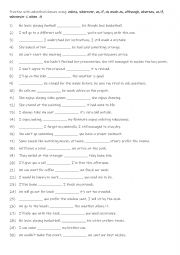
|
A2+-B1 Adverbial clauses 4
Learning adverbial clauses using words like unless, wherever, as, if, as much as, although, whereas, as if, whenever and when helps students express complex relationships between ideas, such as condition, time, contrast, and manner. First, students need to familiarise themselves with the 10 adverbial clauses and their use. Then they read the senten...
Level: intermediate
Age: 10-100
Type:
Downloads: 118
|
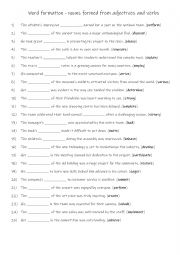
|
Word formation - nouns formed from adjectives and verbs
Vocabulary Expansion: Understanding how to form nouns from adjectives and verbs helps students build a richer vocabulary. For instance, learning that the adjective "happy" can turn into the noun "happiness," or the verb "create" can become the noun "creation," gives you more words to use and understand. Recognising patterns in word formation means ...
Level: intermediate
Age: 8-100
Type:
Downloads: 114
|
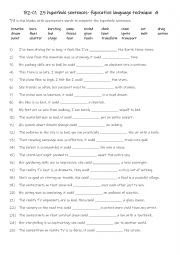
|
B2-C1 25 hyperbole sentences- figurative language technique 4
Recognising and using hyperbole sharpens analytical thinking, as students learn to interpret exaggerated expressions in context. Overall, mastering this figurative language technique makes both written and spoken communication more compelling and expressive. First, students need to familiarise themselves with the 25 words and their meaning. Then th...
Level: advanced
Age: 14-100
Type:
Downloads: 110
|
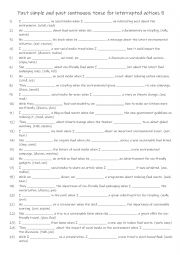
|
A1+-A2 Past simple and past continuous tense for interrupted actions 5
Understanding how to use these tenses together enables students to narrate stories or describe situations more naturally and accurately. First, students need to familiarise themselves with the 2 tenses and their usage. Then they read the sentences to see which one is needed to complete the sentences in a natural way. Answers on page 2
Level: elementary
Age: 8-100
Type: worksheet
Downloads: 106
|
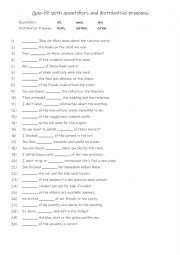
|
A2+-B1 Gap-fill with quantifiers and distributive pronouns
This worksheet gives students this chance to practise using quantifiers and distributive pronouns. In everyday situations, they are used frequently. For example, when shopping, discussing quantities, or distributing tasks, these words help you convey your message more clearly and efficiently.
By learning quantifiers and distributive pronouns, you ...
Level: intermediate
Age: 10-100
Type:
Downloads: 110
|
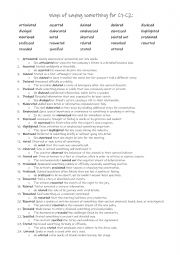
|
24 different ways of saying something for C1-C2
24 different ways of saying something for C1-C2 level. Pre-teach the vocabulary and then use page 2 which has all of the new words and a gap fill reinforcement activity. The answers are on page 3
Level: advanced
Age: 16-100
Type: worksheet
Downloads: 123
|
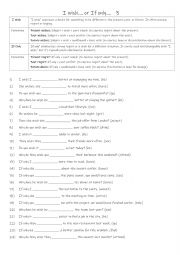
|
B1-B2 I wish�. or If only�. 3
First, students need to familiarise themselves with the 2 patterns and their use. Then they read the sentences to work out which tense is needed to complete the gap-fill using the infinitive in (). Each pattern is used 12 times! Answers on page 2
Level: intermediate
Age: 10-100
Type:
Downloads: 120
|
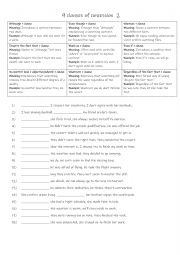
|
9 clauses of concession 2
First, students need to familiarise themselves with the 9 clauses and their meanings. Then they read the sentences to see which one is required to complete the gap-fill. Each clause is used 2 times! Answers on page 2.
Level: intermediate
Age: 10-100
Type:
Downloads: 115
|
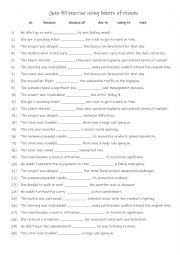
|
Gap-fill exercise using linkers of reason
Students read the sentences and complete it with a suitable linking word. This worksheet is suitable for B1+-B2 level due to complex sentences and vocabulary. Answers on page 2
Level: intermediate
Age: 12-100
Type:
Downloads: 104
|
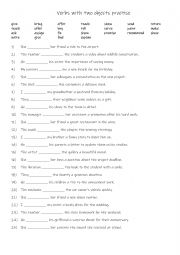
|
B1-B2 25 Ditransitive verbs are verbs with 2 objects practise Part 1
First, students familiarise themselves with the 25 ditransitive verbs. Then they read the sentences to see which verb is required to complete the sentence. Answers on page 2.
Level: intermediate
Age: 10-100
Type: worksheet
Downloads: 132
|












